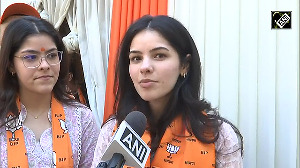Broadcasters across the country are popping the bubbly now that the Telecom Dispute Settlement and Appellate Tribunal has set aside the Telecom Regulatory Authority of India ruling which, they contended, gave cable operators a stranglehold over them. Not surprisingly, cable operators are crying foul and pointing out that customers will have to pay more for television channels they may not even be able to see.
The person at the heart of the controversy, Trai Chairman Nripendra Misra, is maintaining a dignified silence while those close to him point out that the TDSAT setting aside the Trai's Telecommunications [Broadcasting and Cable Services (Second) Tariff (Eighth Amendment) Order, 2007] has set back the progress of the last five years. "The initiatives to make sure that cable operators, DTH owners, Multi-System Operators and broadcasters have a relationship in terms of pricing has been done away with," says one of them.
Since the judgement relates only to non-CAS areas, it will have no impact on the 9.5 million homes that have Direct-to-Home services and another 8 million or so that have Conditional Access Service at their homes through set-top boxes. For the CAS homes, the ceiling of Rs 5 per channel and Rs 77 for the free-to-air channels per month remains. (In this case too, the broadcasters are unhappy and have challenged this in the Supreme Court where the matter is still pending.)
Ashok Mansukhani who is the president of the Multi-Service Operators Alliance an association of top cable operators in the country -- argues that the TDSAT has dealt a body blow to the industry's progress. "We are back to 2004 in terms of the progress of the industry," he says. MSO Alliance was one of the appellants among a battery of cases that TDSAT clubbed together and heard.
Gopal Jain who represented Sony TV and Discovery counters this by saying, "That's because it sets aside a regulation completely skewed towards the cable industry." Other broadcasters who filed the case at the TDSAT were Zee Turner, Star India and Sun TV.
The Trai's 2004 order, given within a short while of the regulator getting the broadcasting mandate in addition to telecom, was to simply freeze the rates to be charged between the broadcaster and the cable operators at what they were in 2003. Later, in 2006, when CAS was to be introduced, the Trai came up with a ceiling price of Rs 5 per channel and Rs 77 per month for all free-to-air channels.
The Trai's 2007 order essentially did the same exercise, for the non-CAS areas, or those areas where having CAS was not mandated by the law. In keeping with the 2004 order, the 2007 order prescribed that the charges payable (by cable operators and MSOs for pay channels in the non-CAS areas) could only be increased at the then inflation rate of 4 per cent.
For any new pay channel launched after December 1, 2007, or any free-to-air channel that converted to a pay channel, the ceiling could be exceeded provided they were stand-alone channels or a part of a new bouquet. In addition, the Trai prescribed a ceiling of between Rs 132 and Rs 260 per month -- on what subscribers would pay to cable operators and MSOs, based on the number of pay channels and the classification of cities.
Lastly, it said that broadcasters must offer their channels on an a la carte basis to the MSOs/ local cable operators. It also gave the chargeable rates for the individual pay channels.
The price freeze on pay channels and choice of a la carte menus to cable operators with suggested prices is what irked the broadcasters who said it was 'without jurisdiction, perverse and arbitrary.' Jain argues that the Trai has made no effort to understand the issue. "There's been complete abdication of regulatory function. For instance, television channels being sold at different prices in different cities is a completely irrational move," he says.
Heads of broadcasting companies, who preferred to let their general counsels talk on their behalf officially, point out that the 2007 order should be viewed against the backdrop of how the television industry has moved. So, they argue, the Trai froze what they could charge for their channels but did nothing about the 'placement fee' that the cable operators charge them to show their channels. According to them, broadcasters in India get barely 20 per cent of the total subscription revenue collected -- the majority share goes to the local cable operators and the MSO.
"How can a manufacturer of a product -- television content in this case -- earn less than the distributor of that content? A regulator does not perpetuate such imbalances but corrects them," is how Jain puts it. The general counsel of another private channel argues that the price ceiling ignored the fact that programming costs of a channel are dynamic. "In fact, freeze on pay channel pricing and, therefore, lower subscription revenue drives broadcasters into showing more sensational stuff that keeps them ahead in the TRP game which is essential to draw advertising revenue. If the subscription money does not go up, they will obviously show sleaze to attract advertisers through ratings," he says.
Not everybody agrees that 2007 Order was pro-cable. "Only the prices of television channels were frozen, the broadcasters' revenue was not. All deals are negotiated on the basis of subscribers. As the television subscribers grew, so did the income of the broadcasters," says a television distribution veteran at the Zee group. And now the price restriction has been set aside by the TDSAT.
What of the impact on viewers? According to Mansukhani who also advises the Hindujas on their cable business, at least 300 new channels have been launched since 2004. "And there is no price freeze on them. Imagine its impact on a television viewer's cable bill."
Secondly, broadcasters will now go back to bundling channels, since the a la carte menu has been quashed. In non-CAS areas, he adds, cable operators will have no bandwidth to accommodate the bouquets. "So I will be paying for channels which I can't show and the consumer may end up paying for channels that he can't see," says a livid Mansukhani.
DTH tariffs could also go up since, based on the 2007 order, the Trai had issued an advisory to broadcasters to give their channels to DTH operators at 50 per cent of their rates in non-CAS areas. For instance, if a channel asked for Rs 10 per subscriber in a non-CAS area, he could ask for only Rs 5 from a DTH operator.
Tata Sky Chief Marketing Officer Vikram Mehra, however, did not comment on the TDSAT order.
Prices, however, may not rise immediately. For one, the TDSAT has given the Trai six months to come up with a fresh, comprehensive order. Also, broadcasters may not wish to annoy their channel distributors in the next two months as they still have to collect dues and meet their annual targets before the year ends. Given the cut-throat competition, it's also not immediately clear how cable or DTH operators will hike prices. In which case, their losses could mount substantially.
And yes, the Trai could just appeal the TDSAT verdict in the Supreme Court. One thing is clear though, a robust regulatory framework that is fair to all stakeholders in the industry is still some time away.







 © 2025
© 2025